Escape Rooms are becoming more and more popular among today’s youth and are a great way to get students’ adrenaline pumping.They consist of adventure type games in which players solve a series of puzzles, mazes, and riddles using clues, hints, and strategy to achieve specified goals. If you’ve tried one you may have thought, wow, my students would LOVE this! I know I did. But how can we integrate this concept to benefit our students in Physical Education and Health?
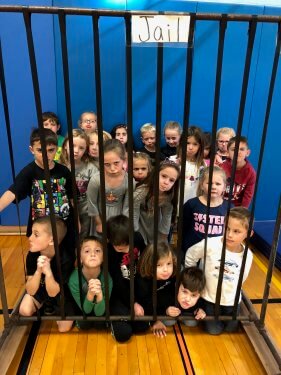
I absolutely LOVE creating Physical Education games, activities, and assessments that integrate health, fitness, wellness, and nutrition concepts. I want my students to break into not just a physical sweat but a mental sweat as well. As a PE teacher, it is a constant challenge to fit everything I want the students to learn into a 40-minute class that meets twice a week. I need to make every PE second count. That being said, Escape Room/ Break out games in PE are the perfect tool.
You walk into the gym and see Buff Bobby Bones in pieces. He has been playing a lot of Fort Night, has not been exercising or eating a balanced diet, and his bones became too weak and fell apart. We have to help put Buff Bobby Bones back together again and figure out the antidote to make sure his bones stay together and strong in the future. Hurry, or else Buff Bobby Bones will never be strong again…
Students in my PE classes love the physical, cooperative, and fitness challenges involved in Escape Room/ Break out games. And it keeps them constantly moving! I’ve created games that are set in a variety of fictional locations, such as the Temple of Doom, trapped on a volcanic island, floating in the digestive system, outer space, in Mr. Pickle’s pickle jar (he is my class mascot), underwater, prison cells, etc. The puzzles, activities and riddles follow the theme of the room. The more ridiculous and bizarre, the better for my elementary students.
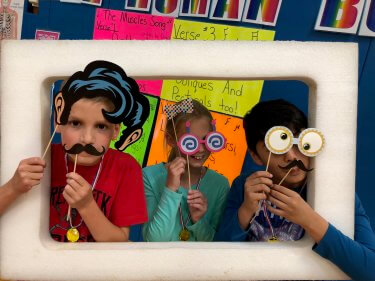
I’ve discovered there are many amazing benefits to using Escape rooms in PE. They are fresh, engaging and exciting for the students! It is a fun way to learn new concepts while working with peers. Social skills such as communication, compromise, problem solving, conflict resolution, exchanging ideas, listening, etc. are developed while playing. It is a different and unexpected way of learning and it will hook the students. Escape rooms spice up learning and really get the students to engage with the content. I tell the students they will need to get “up close and personal with the material” in order to break out.
In the usual Escape Room, players are typically given a 60-minute time limit to solve puzzles and activities then break into a locked box. But for Physical Education this design had many obstacles. I see approximately 6 different classes per day. I might go from teaching a 5th grade class, to a Kindergarten class, to a 4th grade class, back to a Kindergarten class. I have at most 5 minutes to make modifications or change the Escape Room completely to meet the needs of all grade levels. And sometimes I’m scheduled to teach a class that is meeting for the second time that week, then minutes after that class ends teach a class meeting for the first time that week. I would have to set up the Day 2 Escape room, break down the Day 2 Escape Room, set-up the Day 1 Escape Room, then break down the Day 1 room, and so on. How could I possibly break down a complete Escape room and set-up a different one all within minutes? If you have created any Escape Rooms before you know they take a lot of planning, time and strategy
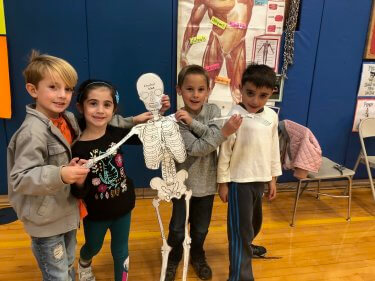
Just thinking about these problems initially made me want to crawl into the locked box! But I came up with a solution. Make a two-class period Escape Room. All grades K-4 have PE twice a week. By making the Escape room longer and with more activities, it takes the students both PE classes to solve the challenges. Now, I don’t have to break the entire room down and all the kids have to do is record where they left off. This allows them to pick right back up the following PE class. What if the students share clues and codes with classes who haven’t seen the Escape room yet? That rarely happens. The students want bragging rights. They are competitive and want to be the only team who succeeds. The teams that win take pictures in my Photo Prop booth and their picture goes on the bulletin board. They’re not inclined to give away the solutions to other classes.
Students feel a sense of camaraderie while participating as they have to collaborate with other students to achieve the goal. Communicating their point of view and persuading their teammates is an essential part of these games. And these are important personal skills students will need in their future lives.
Another great aspect of Escape Rooms is that they are extremely flexible. They can be used in all subject areas and can be specifically tailored to your class objectives. They are even great for reviewing material and preparing for tests. The best part is all students are accountable in the learning process. Due to peer pressure and the competitive nature of the game, students stay on task and remain focused. The “prize” at the end is always a great motivator for the students. I even discovered the value of making a “jail” for students who don’t escape. They take pictures in the jail and pretend they are trapped. Even the winners ask, “Can I take pictures in jail?”
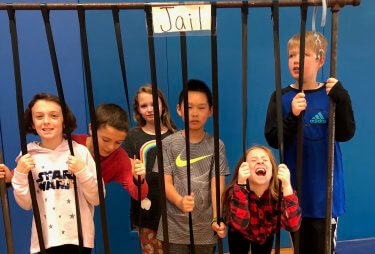
So by now you may be asking, “Okay, where do I start? What do I do?” Well first, I must share this disclaimer: Creating Escape Rooms is EXTREMELY addicting. My brain is alight with new ideas often, and it causes me to wake up in the middle of the night as new ideas pop up. I now sleep with a pad and pen on my night stand. These teaching strategies have truly got my creative juices flowing!
How does it all work? Here are some basics. The teacher hides clues around the gym or leads the students through a list of challenges. Each of these, when solved correctly, leads to a different clue or code to unlock one of the locks on the box. The number of locks used may vary depending on the time you have per class, your budget, or the difficulty of the challenges. The objective is for the teams to solve all clues and challenges to open all the locks on the Breakout box, get the prize, and win the game. Teams can vary in size. I prefer teams of 2-5.
I recently created an Escape Room that focused solely on the 5 Health-Related Physical Fitness Components. The first task consisted of a memory game. Teams had to perform different cardiovascular endurance activities while one teammate at a time, had a turn at the Memory game board. Team members had to flip over two cards and try to find a match.
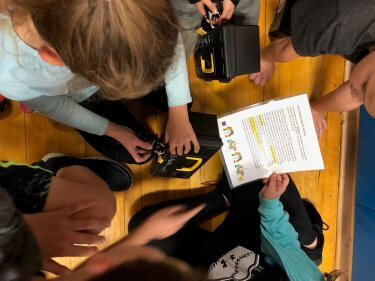
A match consisted of the Health-Related Fitness term with its matching definition. The task card given to each team, stated that when all cards had been matched, the team must look for the code and that the code should be in the following order: Cardiovascular Endurance, Muscular Strength, Muscular Endurance, Flexibility and Body Composition. On each definition, I place a one-digit number. If the students did not match the definition with the correct word then the 5 digit code would be wrong and they could not open the locked box. Students were having conversations and debating Health Related Fitness concepts. It was awesome!
The correct code opened a locked box. Inside the locked box was a spinner, a task card, and an exercise key. The gym was set-up like a giant game of Candyland. Students had to start at the Go sign, spin the spinner, and see which color the spinner landed on. If the spinner landed on red, the students had to move to the red poly-spot and perform the muscular endurance exercise that corresponded with that color. While the students moved through the course, they would come across numbers on the different colored spots. (i.e. The number 7 on the green poly-spot, the number 2 on the yellow, the number 5 on the red, etc.). Students were given a task chart with the picture below.

Students had to figure out that each number corresponded with the correct colored boxes and that this was the order of the numbers in the code. When they came to the end of the Candyland board and figured out the code, they told me and I rewarded them with a blacklight and a clue. The clue was, “Which Health Related Fitness Component was represented by the exercises you performed during the Candyland task? Students would have to go back to the definitions in the first task to learn they were working on their Muscular Endurance. Written in invisible marker, on the Muscular Endurance definition, was a 3-digit code. In order to see it, the students had to use the black light that was awarded to them from the last task. That 3-digit code would open the next box. This is just an example of a portion of that lesson. Visit my website for more ideas.
Like most teachers, I run into the same obstacle when wanting to try out new ideas – cash flow! My husband is constantly reminding me not to spend my whole paycheck on my students. Luckily, I found workable solutions: Use the “dollar” stores. I purchased locks with keys, toolboxes, and dry erase boards there. I then went on Amazon and purchased about ten 3-digit locks. Do you have to use locks? No. There are many inexpensive alternatives.
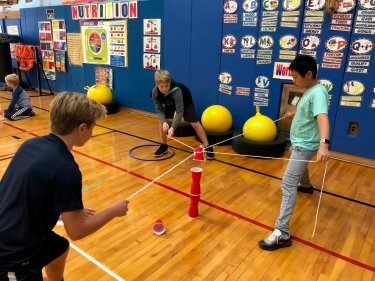
You can have students write the code on a dry erase board. I just went to Home Depot and bought 4-inch bolts and placed 5 hexagon nuts on the bolt. I wrote random letters on each side of each hexagon nut. The students then use it like a lock. You can also use a deck of cards, velcro numbers, popsicle sticks with letters written on them, dice the students flip over to show the correct code, shapes placed in a particular pattern, 4 spaces on paper the student’s fill-in- the world is your oyster! Do you have to use locked boxes? Again, no. Use a pencil pouch and lock it, use a drawstring bag and lock it, use a cardboard box, poke a hole through two perpendicular sides and fit the lock around it. Do not allow money to be a deterrent to creating Escape Rooms/ Games.
Just remember to start simple. Progress to harder Escape Rooms as the students become more familiar with them. If possible, get or create a variety of different locks so that the students do not become confused as to which code opens which lock (key lock, bike lock, 3-digit lock, 4-digit lock, word lock, directional lock, etc.). Very importantly, become familiar with how to reset your locks! This will eliminate a great deal of stress.

When preparing your lesson, keep these questions in mind: What topic are you introducing or reviewing? What do you want your students to learn by the end of the lesson? What are the lesson objectives? Once you decide the content, list the locks you will be using. Next, design the activity/puzzle/ worksheet/ game that will provide the clues for each lock. Make sure that the activity reflects your objectives. What skill do you want your students to practice? Design your clues around that skill.
Don’t forget to have a debrief when ending the game. Allow teams, to discuss successes and failures. What went well? What did not go well? What would you do differently as a team next time? And always allow time for ridiculous fun pictures at the end!

My wife and I have written several breakouts for the Health and Physical Education profession. They are both for box and locks set up as well as digital. It is nice to take advantage of all the equipment PE teachers have at their disposal for breakouts. The set up is always the challenge, and I tended not to offer breakouts to back to back classes. As an alternative is the digital versions. With so many schools going to 1:1 in their district this type of breakout can be very helpful to a busy HPE teacher. Students still have to solve puzzles to gain access to clues which in turn unlock virtual locks. We have tied pedometer use into these digital breakouts, requiring students to not only solve puzzles but to also take and record required numbers of steps to gain access to clues. My students were engaged and dripping with this set up. Please visit our website: cbhpe.org for Breakout games for Health and Physical Education teachers.
Not only is this article extremely informative and inspiring it seems to me to be amazingly well written! Kudos to you Mrs. Bolger! Your passion and expertise fall plainly off the page. Hope others don’t miss out on this treat…
Great article! As Mark mentioned, some of us have been doing the education version called Breakout EDU for years now, and with great success. I myself love physical versions like yours, while Mark and Becky focus on digital ones. Would be great to have you share your version(s) on their site so folks have more options! I have a “shipwreck” team-building version available to folks here (also links to Mark and Becky’s site): http://www.physeddepot.com/breakout-edu-escape-rooms.html